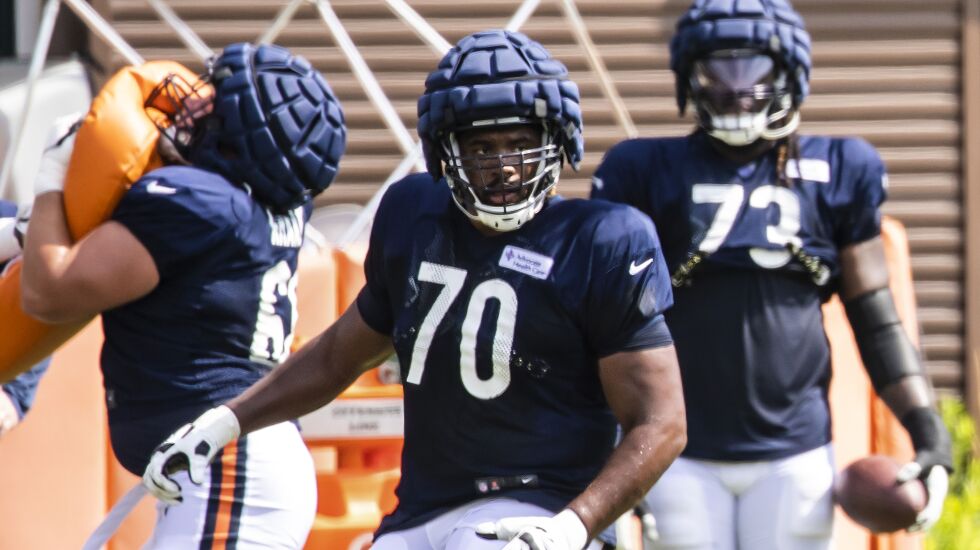
Braxton Jones didn’t expect any of this, never dreamed of it.
He was not the type of kid bent on making it to the NFL, and that would’ve been an outlandish goal while growing up outside Salt Lake City and playing for a high school that rarely attracted big-time college scouts.
It was really as simple as him loving football — and basketball — and pushing relentlessly to perfect his skills. That’s how he has approached his rookie season with the Bears, too, and it has served him well during his climb from being a relatively anonymous fifth-round pick from Southern Utah to taking control of the race for the starting left tackle job.
“My mom has always told me, ‘Anything you pursue, try to be the best at it,’ so it was never that I needed to play in the NFL,” Jones told the Sun-Times. “I loved playing football and basketball, so I’m gonna give those things my all until I can’t do more.”
There’s still a month until the start of the season, so Jones has plenty to navigate, but left tackle belongs to him at the moment.
He surpassed 2021 second-round pick Teven Jenkins almost immediately upon arrival and has fought off, so far, the challenge from 10-year veteran Riley Reiff. Jones is the favorite to start at left tackle, while the race at right tackle appears to be between Reiff and Larry Borom.
The Bears hoped it’d be like this, and it didn’t take long for Jones to show confirmation. He admitted he didn’t walk into Halas Hall thinking he’d win a starting job, but once he got the chance to run with the first-string in Organized Team Activities, he knew that continuing to sharpen his skills would keep him there.
“The biggest thing for me was coming in with open eyes, because you don’t know what’s gonna happen,” he said. “I’m just trying to get better every time I step on the field ... focusing on two or three things each practice.
“You go over the depth chart and see that you’re maybe running with the 1’s today and see how that goes. Either you’re ready or you’re not. But after you get in there and get going, you do what you’ve gotta do.”
Jones says “maybe” a lot, as though he already realizes how little security there is in this league. He’s operating in “a happy medium between cockiness and confidence” as he stays humble enough to learn but bold enough to take on any competitor.
That’s the essence of how he reacted to the Bears signing Reiff the day before training camp opened. As if it wasn’t hard enough to outwork Jenkins and anyone else who wanted the left tackle job, now the team was bringing in someone with almost 9,000 career snaps who started 12 games for the Super Bowl Bengals last season.
“It’s another great opportunity,” Jones said matter-of-factly. “You can learn from him. The dude’s been around; I haven’t. The other thing is competing. You may watch him, but you try to do that better than him.”
If Jones, 23, lives up to what the Bears have sketched out as his potential, he could end their tumult at one of the most crucial positions.
Charles Leno made the Pro Bowl during the exhilarating 2018 season, then struggled so much the next season that a month into it he needed to do “some real deep searching” about his performance. Going into last season, as salary-cap consequences squeezed former general manager Ryan Pace, the Bears cut Leno and committed to Jenkins.
Jenkins, a prospect with a history of back trouble who had mostly played on the right side in his career, ended up missing most of his rookie season because of back surgery and struggled at left tackle when he returned in December. In the meantime, the Bears relied on 39-year-old Jason Peters. He was good, but that was never going to be a long-term solution.
In Jones, new general manager Ryan Poles saw his ideal left tackle. Even after going all in on football, his physique looks like it’d still work for basketball. He’s 6-foot-5 and a lean 310 pounds, whereas Jenkins played at 345 last season. There really hasn’t been much physical transformation for Jones because he already fit the profile when he arrived.
He has also passed all the tests along the way in terms of picking up the scheme, adopting technique and every mental aspect of playing in the NFL.
“Certain things just come quick in the playbook — they’re kind of repetitive and just set in my mind; some other guys, that’s not the case,” Jones said. “The edge for me is really getting down certain details [and] getting down my punch timing and getting off the ball and using the snap count to my advantage.”
The most puzzling part of Jones’ rise is how unnoticed he went before Poles drafted him. How did someone with the potential to start at left tackle as a rookie slip past Oregon or USC — or even a nearby mid-major like Utah State? And even then, if he’s truly this good, how did he slide to No. 168 in the draft?
“He’s always been at small programs, so he wasn’t really seen,” said former Southern Utah coach Demario Warren, now Boise State’s cornerbacks coach. “But we always knew he had a chance to go pro, and he came into his own his junior year. We’ve had some good defensive ends over the years. Once he started locking those guys up all the time, we thought, OK, this guy’s a little different.”
The Southern Utah staff saw something in Jones that everyone else missed. And now the Bears think that’s the case once again.







